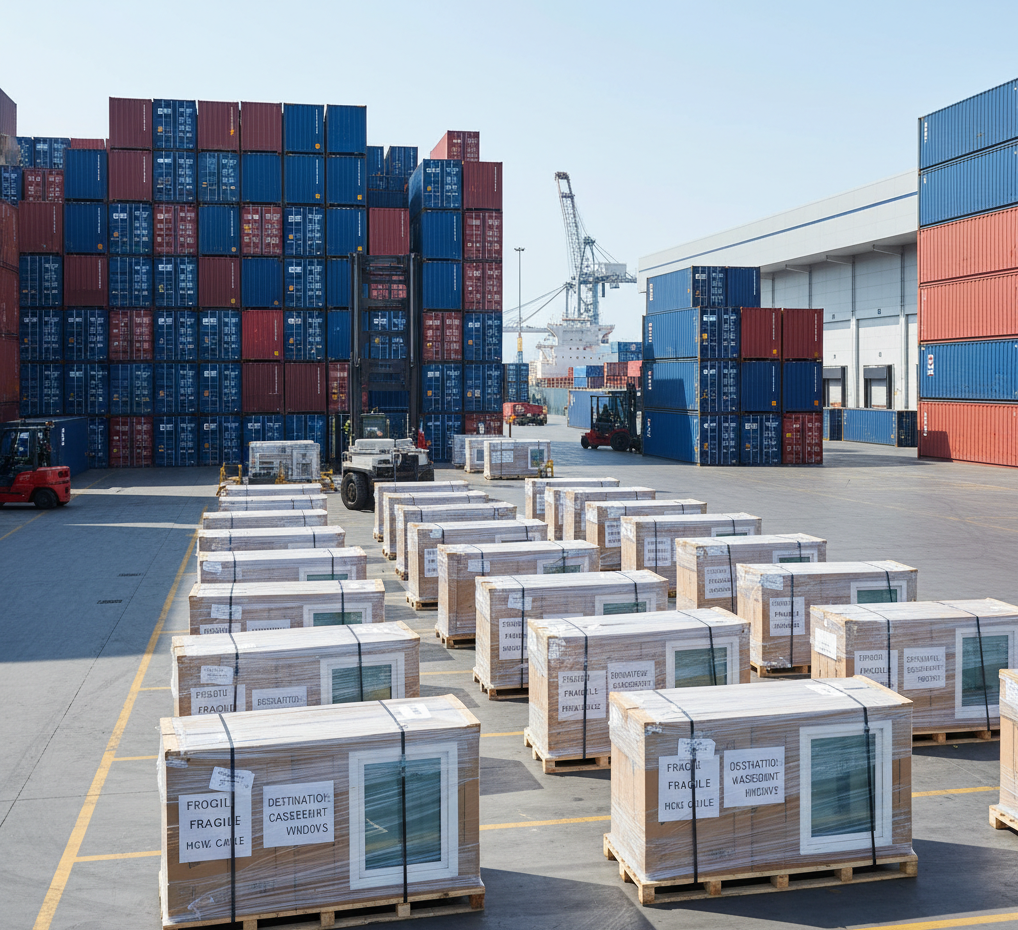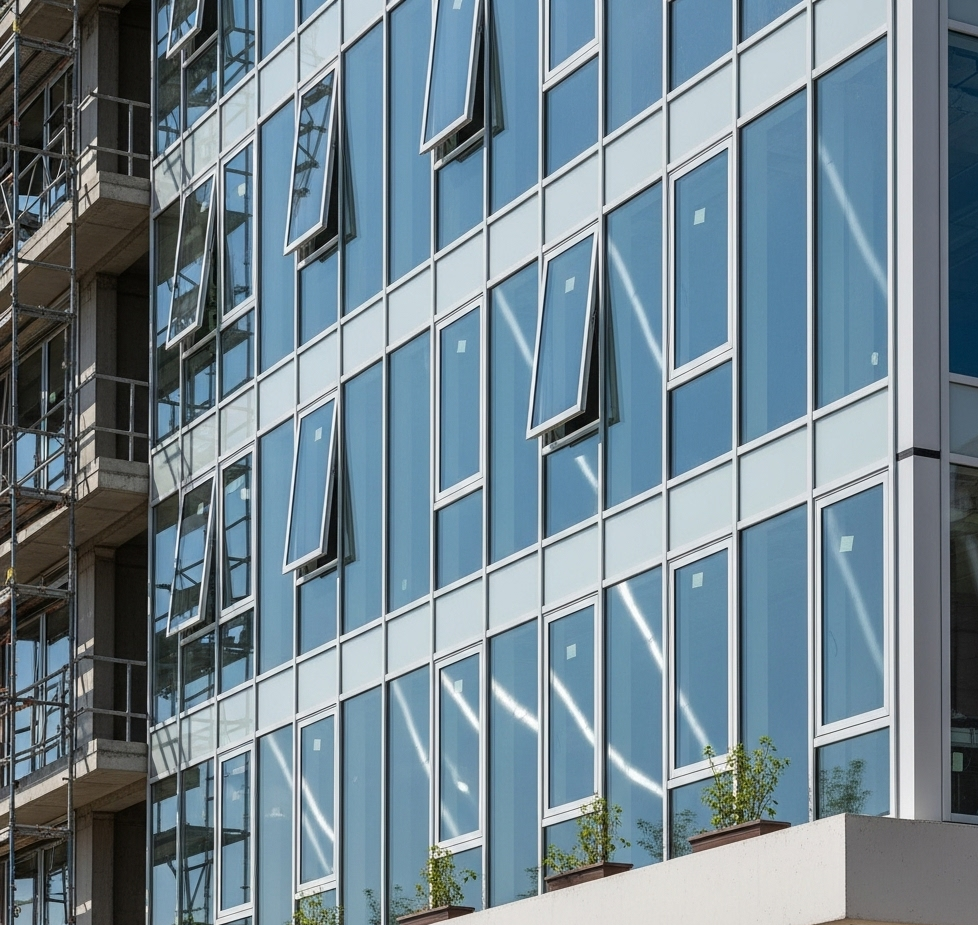Key Takeaways:
- uPVC casement windows offer durability, energy efficiency, low maintenance, and cost advantages for large-scale projects.
- Compliance with wind load, water tightness, thermal insulation, and acoustic standards is essential in commercial applications.
- Bulk procurement requires supply reliability, consistent quality, export certifications, and technical installation support.
- Sustainability benefits include recyclability, thermal efficiency, long lifecycle, and support for certifications like LEED and BREEAM.
For architects, builders, and project developers, choosing the right fenestration system is not just a design choice; it directly impacts building safety, efficiency, and long-term performance. In large-scale projects, where hundreds or thousands of windows must perform reliably, the decision becomes even more critical.
uPVC casement windows have become a preferred option for commercial, residential, and institutional developments. Known for their durability, energy efficiency, and design flexibility, they provide consistent performance across different building types, from high-rise towers to schools and hospitals.
Still, specifying uPVC casement windows at scale requires more than selecting a standard product. Stakeholders must evaluate compliance, structural strength, sustainability goals, and procurement strategies to ensure each unit meets project demands.
This article highlights the essential factors to evaluate when specifying uPVC casement windows for large-scale construction projects, from compliance and performance standards to sustainability and procurement challenges.
Advantages of uPVC Casement Windows in Large-Scale Construction
Core Benefits
- Durability: Resistant to corrosion, moisture, and harsh climates.
- Energy Efficiency: Excellent thermal insulation compared to aluminum or steel frames.
- Low Maintenance: Easy to clean and maintain over time.
- Design Flexibility: Wide range of finishes, sizes, and hardware options.
- Cost Efficiency: Particularly well-suited for bulk procurement of windows in large projects.
These qualities make uPVC casement windows a practical choice for large-scale residential, commercial, and institutional projects.
Architectural Window Specifications
Compliance with Window Performance Standards
- Must align with regional building codes on safety and energy efficiency.
- Ensure compliance with wind load and water tightness requirements for high-rise or exposed locations.
- Acoustic ratings are critical in urban or mixed-use developments.
Thermal Insulation Requirements
- Multi-chambered profiles reduce thermal transfer.
- U-values should meet or exceed minimum efficiency targets.
- Advanced glazing improves insulation, comfort, and energy savings.
Structural Integrity of Fenestration
- Reinforced frames improve strength for large-scale or high-rise projects.
- Tested for impact resistance and operational longevity.
- Must perform consistently over thousands of open-close cycles.
Installation Challenges in Large-Scale Projects
Installation in commercial developments requires precise coordination:
- Bulk Logistics: Large shipments must be organized to prevent site congestion.
- Storage & Handling: Protecting window units on-site is essential to prevent damage.
- Sequenced Installation: Aligning window installation with other construction activities avoids costly delays.
- Skilled Labor: Poor installation undermines window performance; training is key.
Suppliers with experience in large-scale commercial fenestration systems often provide technical guidance to help overcome these challenges.
Sustainability in Construction Materials
Sustainability is increasingly a non-negotiable factor in modern construction.
- Thermal efficiency reduces building energy consumption.
- Long lifecycle reduces replacement frequency and waste.
- Recyclability ensures uPVC can be reused in future applications.
- Supports green building certifications such as LEED, BREEAM, or EDGE.
For developers, these features provide long-term savings and align with global sustainability goals.
Comparison: uPVC vs Aluminum Windows for Commercial Fenestration
| Feature |
uPVC Casement Windows |
|
| Thermal Insulation | Excellent, multi-chambered profiles reduce heat loss | Lower without thermal breaks |
| Durability | Resistant to corrosion, moisture, and chemicals | Strong but requires protective coatings |
| Maintenance | Minimal upkeep required | Periodic treatments needed |
| Cost Efficiency | Affordable, especially in bulk | Higher upfront costs |
| Customization | Wide variety of finishes and glazing | Flexible, but less insulating |
| Sustainability | Energy-efficient and recyclable | Recyclable but higher embodied energy |
For large-scale projects, uPVC typically provides the best balance of performance, affordability, and compliance.
Commercial Project Window Customization
Every large-scale development has unique requirements:
Design Flexibility
- Tailored dimensions for diverse architectural needs.
- Wide choice of finishes, including wood-grain laminates.
- Custom glazing for noise control, safety, or energy efficiency.
Functionality Enhancements
- Integration with multi-point locking systems for security.
- Automated or smart window solutions for modern commercial projects.
- Options for high acoustic performance in noisy environments.
Customization ensures that commercial fenestration systems enhance both functionality and architectural design.
Bulk Procurement and Export Considerations

Large-scale projects require not only quality products but also efficient procurement strategies.
Key Considerations
- Supply Reliability: On-time delivery of bulk orders.
- Quality Consistency: All units must meet identical performance standards.
- Export Certifications: Compliance with international codes such as CE, ASTM, or ISO.
- Technical & After-Sales Support: Essential for installation guidance and warranty coverage.
- Cost Effectiveness: Bulk purchasing agreements often secure competitive pricing.
Global suppliers specializing in high-quality casement window export ensure smoother procurement for wholesalers, distributors, and contractors.
Conclusion
Specifying uPVC casement windows for large-scale projects involves balancing compliance, performance, sustainability, and procurement efficiency. With their thermal efficiency, durability, and customization potential, uPVC casement windows are an excellent choice for commercial and residential developments.
By carefully considering performance standards, installation challenges, and bulk procurement logistics, stakeholders can ensure that their chosen commercial fenestration systems deliver long-term value while meeting modern construction demands.
FAQs
Are uPVC casement windows suitable for high-rise projects?
Yes. Reinforced uPVC casement windows are engineered for the demands of tall buildings. They undergo rigorous testing to ensure:
- Wind load resistance for high-pressure environments
- Structural integrity with steel or aluminum reinforcement
- Water tightness and air leakage control to protect interiors
- Acoustic insulation options for noise-sensitive urban sett
What certifications should be prioritized in window procurement?
When sourcing windows for large-scale projects, prioritize products that comply with international benchmarks such as:
- CE (Conformité Européenne) – European market compliance
- ISO (International Standards Organization) – Quality and safety management standards
- ASTM (American Society for Testing and Materials) – Performance and durability testing
These certifications provide assurance of safety, quality, and global market acceptance.
Can Oridow support compliance with regional building codes?
Yes. Oridow’s windows are manufactured to meet global certifications (CE, ISO, ASTM), making it easier for architects and contractors to navigate diverse building code requirements across markets.
Can uPVC casement windows be customized for large-scale projects?
Yes, dimensions, finishes, glazing, and hardware can be customized for specific project requirements.
How do uPVC windows support sustainability in construction?
uPVC windows contribute to sustainable construction goals by:
- Thermal efficiency: Reducing energy demand for heating and cooling
- Longevity: Extended product lifecycle with minimal maintenance
- Recyclability: uPVC can be reused in future applications
- Green certifications: Supporting LEED, BREEAM, and other standards
What challenges arise in bulk procurement of windows?
Key challenges include maintaining quality consistency, managing logistics, and meeting varied building codes.
How does Oridow contribute to sustainability goals in projects?
Oridow’s uPVC casement windows are designed to align with modern sustainability targets by offering:
- Thermally efficient profiles to reduce operational energy costs
- Durable construction that extends product lifespan
- Recyclable materials to minimize environmental impact
- Compliance with global green building standards for certification support





